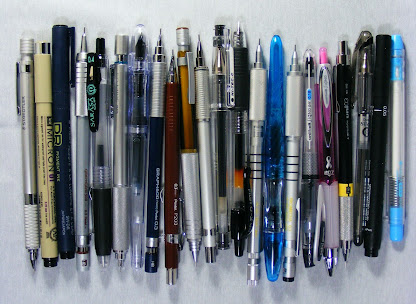
Christmas is supposed to come only once a year. For me it came twice, once on December 25st and then again on December 28th when I went to the mailbox. There amongst the bills and flyers was a small white package from
JetPens. This was a surprise as I had already received my order from
JetPens and I wasn’t expecting any items for review. When I opened it there to my utter surprise was an Ohto Super Promecha PM-1503S 0.3mm drafting pencil! Along with the pencil was a note from
JetPens telling me it was a Christmas present. WOW! I was floored. The pencil has been discontinued but still it’s an Ohto Super Promecha 0.3mm pencil! So why get so excited about a discontinued pencil? It’s an Ohto Super Promecha 0.3mm pencil! OK, it’s an Ohto Super Promecha 0.3mm pencil, but it’s been discontinued, so why blog about it? Because it let’s me compare the old design with the new (see my review of the
Ohto Super Promecha PM-1505P 0.5mm Pencil) and it’s an Ohto Super Promecha 0.3mm pencil!
The PM-1503S breaks down into 12 parts/sub assemblies. They are, from the top down, the push button (consists of the top retainer, lead grade indicator and lower retainer), pocket clip retainer, pocket clip, upper body, grip sleeve (also serves as a wheel to extend/hide lead sleeve), lower body assembly (consists of the lower body shell, lead length adjustment wheel, clutch assembly and lead reservoir), tension spring (gives tension to lead adjustment wheel and lead sleeve adjustment wheel), end cap (contains the lead sleeve adjustment wheel) and the lead sleeve. Only the PM 1503S’s replacement, the SP-1503P, is comprised of more user accessible parts by 1 part.
The Ohto Super Promecha is a marvel of engineering. It is even more complex than the pencil that replaces it. There are five individual adjustments available to the user of the Super Promecha. They include the lead grade indicator, the pocket clip, the length of lead projected with a single click, the length of the lead sleeve available for exposure, and the lead sleeve exposure. As far as I know these are the most user adjustments available on any drafting pencil available.
To adjust the lead grade window remove the push button from the pencil, hold the lower retainer and lead grade indicator window while loosening the top retainer slightly. Move the window to the desired lead grade. While holding the lower retainer and lead grade indicator tighten the upper retainer then replace the push button. The pocket clip is easily removed should you wish by first removing the push button, then holding the pocket clip so it doesn’t move, loosen and remove the pocket clip retainer. Remove the pocket clip and replace the retainer. The advantage to not having a pocket clip on a pencil is if, like me, the pencil has a tendency to roll in the hand when writing the removal of the pocket clip allows the pencil to rotate freely without the pocket clip interfering with the web of the hand.
The regular Ohto Promechas that I have project too much lead if the push button is pressed more that once before the lead has been used up. With the Super Promechas there is an adjustment just above the grip sleeve that allows for the adjustment of the amount of lead projected with each press of the push button, from 0mm to 2mm. Lowering the wheel (turning it to the left) decreases the amount of lead projected with each press of the push button while raising it (turning it to the right) increases the amount of lead projected. This is, to me, the most useful of all the adjustments available on the Super Promechas. I keep mine set to where it takes 4 clicks in order to get enough lead to write with, about 1mm. This is because when writing I have a tendency of pressing the push button a time or two in order to project more lead whether it’s needed or not.
The grip sleeve also serves as the wheel that hides or shows the lead sleeve. It also allows the user to adjust the amount of lead sleeve projected within the confines set by the lead sleeve adjustment wheel below the grip sleeve inside the end cap. Turning the grip down (to the left) hides or shortens the lead sleeve. Turning it up (to the right) shows or lengthens the lead sleeve. On the latest model of the Super Promecha this is the only lead sleeve adjustment available. Ohto saw the duplicity in having this adjustment and the one in the end cap and eliminated it.
The lead sleeve adjustment in the end cap sets the maximum amount of lead sleeve the prior adjustment is allowed to show, from 0mm to 4mm. Since the grip adjustment can regulate the amount of the lead sleeve shown the lead sleeve adjustment in the end cap is rather redundant. This is probably why Ohto redesigned the pencil to eliminate this redundancy. To set the length of the lead sleeve turn the wheel down (to the right) to show less lead sleeve and up (to the left) to show less. I just keep mine set to the maximum of 4mm.
A word about the ‘sliding sleeve’ of the Ohto Super Promechas. A true sliding sleeve is just that. The lead sleeve retracts back up into the end cap generally with the help of users finger. The sleeve has a plastic cone on the back end of it that acts as a stop to keep the sleeve from exiting the end cap. It extends, when the lead is first projected, by the jaws of the clutch system, just before they begin to offer out lead. The lead sleeve will remain there until it is pushed back up into the pencil by hand. The problem with this system is that the lead sleeve can work loose and the lead begins to break when writing. The System used by Ohto employs a fixed lead sleeve that is shown or hidden by the movement of the end cap of the pencil. This system makes the lead sleeve just as stable as any other fixed sleeve pencil.
The Ohto PM-1503S is a very attractive drafting pencil. It is all sliver, being made of aluminum and brass, except for the reservoir, which is plastic. The grip is round and finely knurled making it very comfortable to hold and easy to control. The body is 12-sided alternating wide and narrow flats with the info imprinted on one side in yellow. The lead size is indicated in black on yellow on a sticker in the center of the top of the push button. The pencil is 1421.8mm long; 92.5mm in diameter at it’s widest. The balance point is approx.92.5mm from the end cap, making the pencil very bottom heavy. This is something I like especially when the pencil weighs 28 grams! That makes the Ohto Super Promecha the heaviest pencil that I have.
I like the weight of the pencil. It feels good in my hand, rock solid and steady. It projects the feeling of good quality and design. I’ve liked Ohto pencils ever since my first one (despite it’s tendency to project too much lead). However the Super Promecha is at the top of the class when it comes to drafting pencils. What I once thought as “gadgets” have turned out to be well conceived ideas, more than one of which I like very much.
While the PM-1503S has been discontinued by Ohto, it has been replaced with the Ohto Super Promecha PM1503P (see my review of the
Ohto Super Promecha SP1505P). While JetPens is currently out of 0.3mm Super Promechas when they do get more in they will be of the new PM1503P’s. I highly recommend that if you want a great, fully adjustable 0.3mm drafting pencil that you get hold of an Ohto Super Promecha SP1503P from
JetPens ASAP.

 After returning some pens to Staples the other day I ran across these house brand liquid rollerball pens. I figured that since they were a buck less than what I'd just returned and there were two more pens in the pack I figured that I couldn't do any worse than what I returned. The package read that they were 0.5mm rollerball pens and that the ink was acid free. So I thought that I'd take a chance on them. I opted for the six pack with the four colored inks, 2 black, 2 blue, a red, and a green.
After returning some pens to Staples the other day I ran across these house brand liquid rollerball pens. I figured that since they were a buck less than what I'd just returned and there were two more pens in the pack I figured that I couldn't do any worse than what I returned. The package read that they were 0.5mm rollerball pens and that the ink was acid free. So I thought that I'd take a chance on them. I opted for the six pack with the four colored inks, 2 black, 2 blue, a red, and a green.























